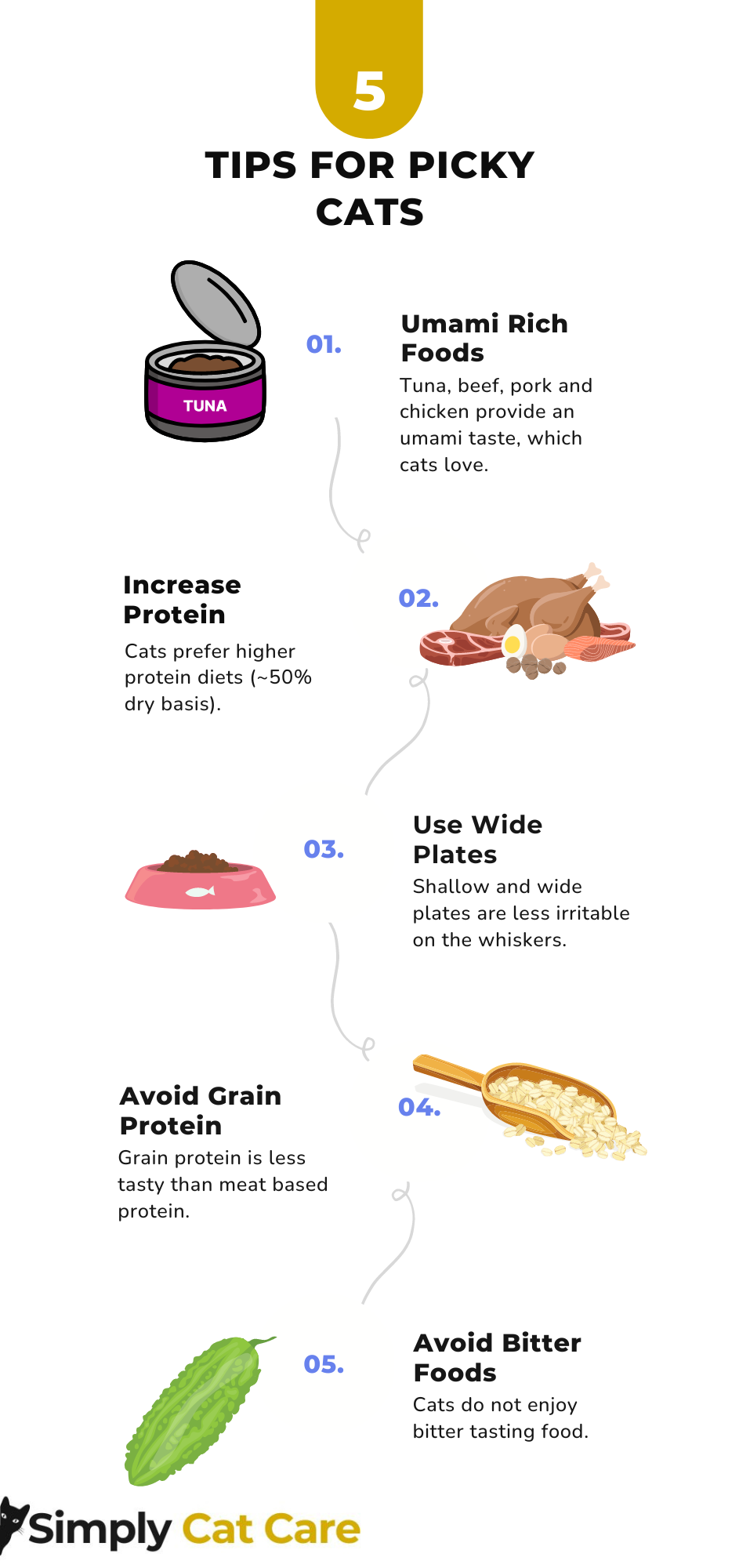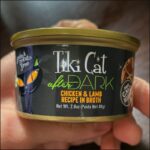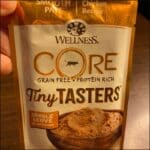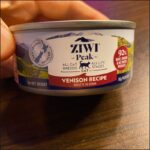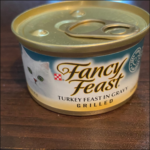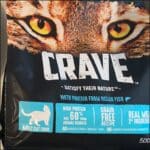It’s a pain having to buy cat food and hope it doesn’t go in the bin.
The solution?
Try offering a high protein and low carb diet. Aim for around 50% protein on a dry basis.
Animal protein is the tastiest protein, whilst grain protein is less desirable.
Find food that hits this sweet spot of nutrition and ingredient quality for a better chance of success.
In this guide, I’ll go through in more detail about the what to feed a picky cat, then I’ll go through my best wet cat food for picky eaters.
6 Best Wet Cat Foods for Picky Cats: A Quick Look
How to Choose the Best Cat Food for Picky Cats
Cat food chock full of animal protein is best.
In the wild cats are strict carnivores, who thrive off animal-based foods.
If that’s how cats have gotten by for tens and thousands of years, it stands to reason it’s a good place to start.
As cats rely on meat, they’re adapted to detecting the meatiness of cat food.
This is shown in research with cats having taste buds that detect umami and kokumi flavors, but not sweet items.
Cats eat meats, not sweets.
More specifically:
In a 2016 study, 39 cats tested four different foods prepared with different macro ratios. Served together, cats showed a preference for a diet with
- 52% protein
- 36% fat
- 12% carbohydrate (or less)
Adding flavors to the food didn’t change the dietary preference in this study.
So, a good starting point is to find cat food close to this ‘sweet spot’ for macronutrients. This is going to improve your chances of success.
But what types of food do cats prefer…
What Foods Do Cats Like Most?
Cats enjoy the following foods most:
- Liver
- Red meat
- Fish
- Blood
Darn vampire cats.
Cats also have less preference for non-essential protein sources (e.g. collagen).
Lower quality cat food tends to use more collagen rich by-products. They might not be as tasty for this reason.
Similarly, grain based protein (e.g. corn gluten meal) is less tasty than meat. A recent study showed cats prefer meat or soy based protein over corn gluten meal.*
The good stuff is meat, and cats are smart enough to detect it.
*The study showed cats will accept corn fermented protein, but this isn’t used in pet food as yet.
Amino Acid Preference
Cats seem to prefer certain amino acids.
Histidine is an amino acid with a strong umami flavor that cats love. It’s very high in all types of tuna (e.g. albacore, skipjack).
Histidine is also an essential amino acid, so it makes sense that cats are drawn to it.
Another paper suggested cats don’t like bitter tasting amino acids including tryptophan and phenylalanine.
Instead, the sweet tasting amino cysteine is tasty. Chicken, beef, pork, tuna and soy flour are high in cysteine.
Foods have a mix of amino acids.
The ratio of tasty amino acids (sweet and umami) to not-so-tasty (bitter) will influence what cats want to it.
Switch It up With Some Variety
Nobody wants to eat the same thing every day…and neither does your cat.
If limited to one flavor, cats start rejecting meals. This is an evolved strategy to avoid nutrient imbalances.
The technical term for this is neophobia.
The simple solution is to change it up.
Pretty simple right?
Sure.
Problem is, cats need time adjusting to new things. One new food rejected is enough to give up, but give it time and mix in new flavors slowly.
Research suggests cats need two tries to get used to new food.
One try is not enough.
Many cat foods have generic flavors like chicken. Don’t be afraid to venture out and try things like duck, lamb, salmon, or turkey.
Feed Your Cat What They Got as a Kitten
Cats build food preferences as kittens.
If a kitten eats a wide variety of different meats they are less likely to wind up picky adult cats.
Taste preferences are also passed via the milk of a kittens mother. So look at the mother cats diet.
Boost The Fat Content
When given a choice, cats prefer a higher fat diet.
Animal fats like salmon oil increase your cat’s liking of canned food.
Why is salmon is a cat favorite? Cats have strong odor senses, so they may pick up on the smell of salmon.
Cats are averse to medium-chain triglycerides. Coconut and palm oil are two foods high in medium-chain triglycerides.
A cat doesn’t need plant based fat in their diet, since they can’t utilize the nutrient linoleic acid, which needs to get converted to arachidonic acid.
Instead, they require preformed arachidonic acid found in…yep, you guessed it. Meat.
Using High Quality Food
Cats don’t have as many taste buds as other animals including dogs, but they have a superior sense of smell.
A cat doesn’t like consuming long dead animals.
They are averse to decomposed flesh which contains monophosphate nucleotides. Cats use their sense of smell to detect decomposing flesh – and avoid it.
Cellulose is a thickener and anti-caking agent added to many cat foods which cats don’t like.
This sense of smell may put cats off food with an off smell. In general, shredded meats (e.g. Tiki Cat After Dark) are fresh smelling and less likely to get a picky cat offside.
In my experience budget cat food has variable smell and results.
Other Tips for Picky Eating
Know Your Cat
In a 2019 study on hairball control diets some cats rejected a dry cat food diet.
The researchers improved adherence by added artificial flavors (a common cat tactic), but one cat still refused to eat the food and got removed from the study.
This suggests some cats are pickier than others and won’t fall for cheap tricks.
Warm it Up
Cats have strong smell receptors. Allow your cat to learn and accept the new smell.
Older cats may need more time to adjust to new foods. Aging results in a loss of olfactory receptors which reduces the sense of smell.
This means a senior cat has a harder time detecting the quality of food given to it and will stick to familiar food.
Use a Wider Plate
Picky cats may prefer a clean and shallow plate to eat off, as this doesn’t cause friction on the whiskers.
What if a Cat Refuses to Eat?
If your cat is not eating any food, they may have a health condition.
There are many health conditions that reduce appetite (e.g. gastroenteritis) and stop your cat from eating.
Sometimes a fussy cat is an unwell cat.
If your cat hasn’t been eating for over 24 hours, or you notice any other symptoms (e.g. cat stops grooming, low activity) then speak with a vet.
6 Best Wet Cat Food for Picky Eaters
I graded popular cat foods on nutrition, ingredients, and taste (from my testing and customer ratings).
Tiki Cat After Dark came out on top as the best overall choice. It scores well across the board, but is a little pricier than most.
To make things easier I’ve added ratings and comparative criteria. See our testing methodology for how we score cat food.
Overall Best: Tiki Cat After Dark
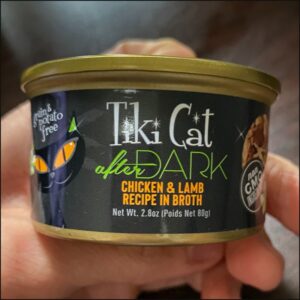






Tiki Cat After Dark stands out for quality, freshness, and protein content.
Out the tin you get shreds of chicken breast and real organ meat. It looks better than a lot of human food and smells fresh.
In my experience, my male cat Maxie munched a full tin with no problems. My other kitten took some time, as she’s a kibble-lover.
The price is high, but arguably worth it with the stand out quality.
Human grade quality shreds
Complete for all ages
Soy free
Grain free
Very pricey
Could use more flavors
78% protein
0% carbs
16% fat
751 kcal/kg
12 x 3 oz. packs available
$0.62 cost per oz.
Made in Thailand
Shredded texture
Runner Up: Wellness Core Tiny Tasters
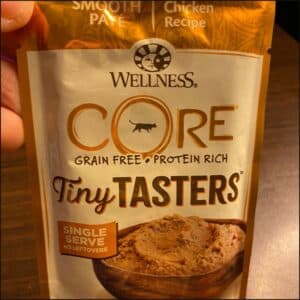






Wellness Core is another cat food that’s meat based and doesn’t include grain protein.
With a macro ratio that lines up with a cats preferred amount of protein, fat and carbs it’s hard to go past.
Massive variety of flavors including tuna, which is a great option for a picky eater.
The easy to chew pate is also great for cats with dental issues. Available in kitten packs too.
The price is also a little high here.
Great variety of flavors
Complete meal for adults
Soy free
Grain free
Very pricey
Pate texture not for all cats
47% protein
4% carbs
39% fat
1,291 kcal/kg
12 x 1.75 oz. packs available
$0.71 cost per oz.
Made in Thailand
Pate texture
Best for Kittens: Wellness Core Tiny Tasters Kitten
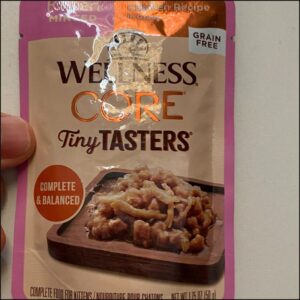






I couldn’t find a better option for kittens than Wellness Core Tiny Tasters…again.
This one has rave reviews and I had great results too. With nutrition that lines up for picky cats it’s hard to go past.
They offer shreds and pate options.
The real issue is there’s only one flavor – chicken. Could use a tuna one as well.
Price is also a little on the exorbitant side.
Shreds and pate texture
Complete for growth of kittens
Soy free
Grain free
Very pricey
Only offer chicken flavor
60% protein
2% carbs
28% fat
1,040 kcal/kg
12 x 1.75 oz. packs available
$0.58 cost per oz.
Made in Thailand
Pate or mince texture
Best for Seniors: Ziwi Peak
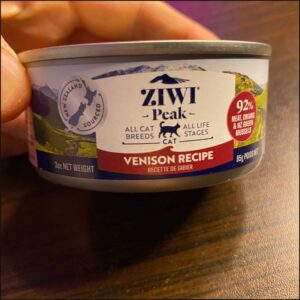






Ziwi Peak is complete nutrition for all ages.
It comes in a pate texture which is easier to chew for older cats.
This food is good for the joints with an added omega 3 food source, green mussels.
Another pricey cat food though.
Has added chickpea which isn’t optimal, but the amount is low compared to the meat content. Macros still line up well for picky eating.
Easy-to-chew pate texture
Complete for all life stages
High in omega 3 for joints
Grain free
Pricey
Added chickpea
54% protein
10% carbs
25% fat
1,200 kcal/kg
24 x 3 oz. packs available
$1.00 cost per oz.
Made in New Zealand
Pate texture
Affordable Pick: Fancy Feast Classic
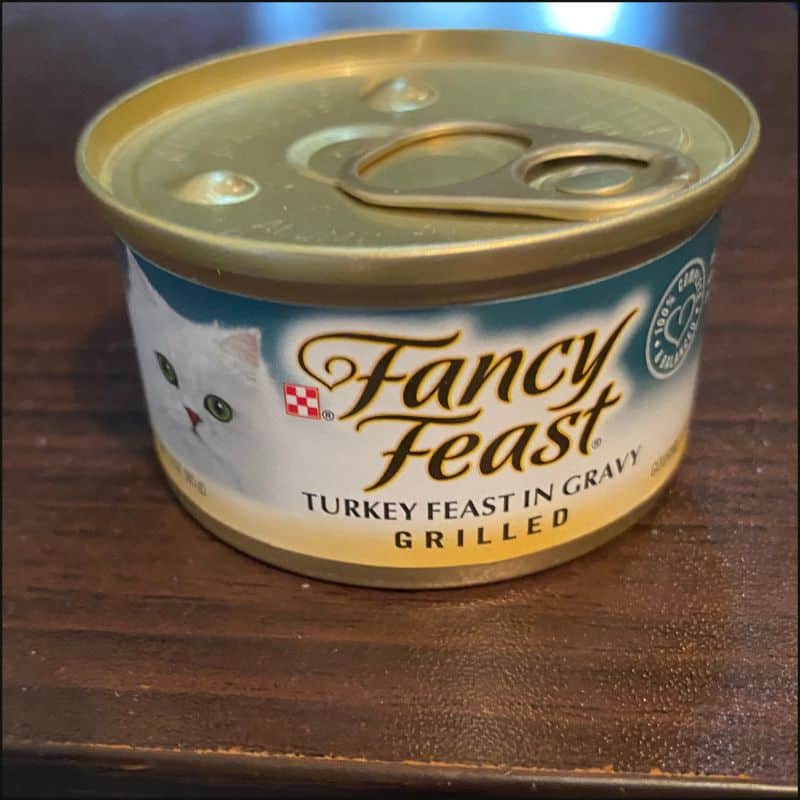






Fancy Feast is a reliable budget pick.
There’s a lot of variety in a range of textures with the classic range.
All of them contain animal protein and no grain based protein.
My results with Fancy Feast are good compared to some questionable looking cheaper cat food.
The smell is a bit average though I’ve found.
Variety of flavors
Complete for all adults
Variety of textures
Grain free
Can smell a bit
Uses meat by-products
48% protein
5% carbs
27% fat
1,184 kcal/kg
24 x 3 oz. packs available
$0.28 cost per oz.
Made in USA
Mince, pate and gravy
Best Dry Food: Crave
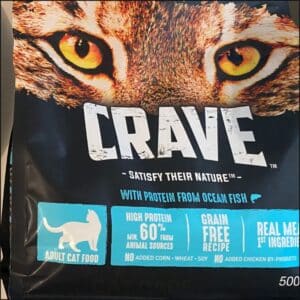






Most dry cat food is lower quality than wet food. That’s just how it is.
Crave doesn’t include grain protein which is less tasty than meat or even peas.
At around 22% carbs, it’s lower than most dry food options which push over 30%.
More importantly, it tastes great and it’s affordable.
I’ve had no troubles putting this on the plate, although I don’t tend to use dry food as anything more than a snack.
A few tweaks to the ingredients could make this better. Could use more flavors.
Smells great
Complete for all adults
Lower carb than most dry foods
Grain free
Could use more flavors
Could be improved
44% protein
22% carbs
20% fat
3,788 kcal/kg
10 lb. packs available
$0.29 cost per oz.
Made in USA
Kibble
Final Thoughts
Picky eating is common in cats.
As carnivores, cats evolved to eat meat. The simplest solution is to give cats a range of meat and organ foods.
Research supports this showing cats prefer a higher protein diet that’s lower in carbs. Many companies try to get around this using meat flavors.
Grain based protein is not very tasty, whereas foods like tuna are attractive.
Try using a wet cat food without grain based protein and consider different flavors to find what works best.
Our top pick for picky cats below:
Related articles:
